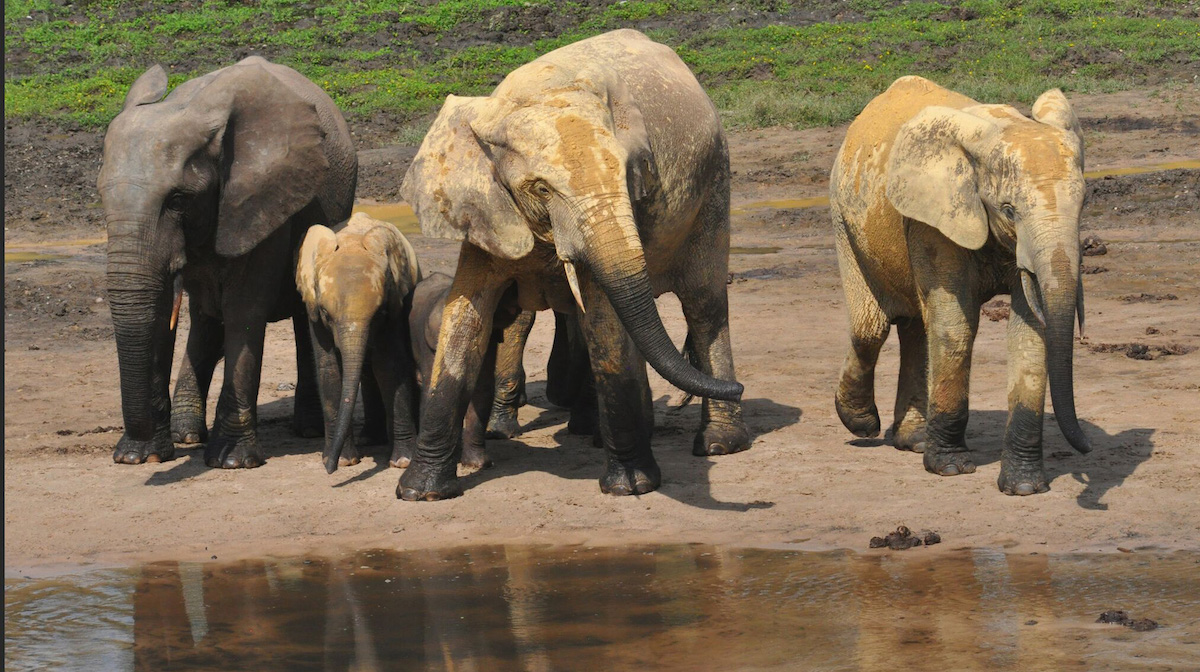
Todd McGrain knows the importance of conservation. The artist turned filmmaker is best known for his Lost Bird Project, a series of larger-than-life sculptures dedicated to five extinct North American bird species. While this endeavor was chronicled in the 2012 film of the same name by Deborah Dickson, now McGrain himself has stepped behind the camera to bring us the story of another endangered species, one we might actually be able to save: the forest elephants of Bayanga, Central Africa. Elephant Path (or “Njaia Njoku” in the Bayaka language) has a lot going for it: a heart-wrenching story, impressive scope, engaging characters, and above all a sense of showmanship. McGrain’s storytelling approach is stylish and highly cinematic to the point where, by the end of the film’s 79 minute run-time, it’s a shock to realize how little has actually happened.
The story of “Dzanga Bai” (“Elephant Village”) is presented through a quartet of characters. Andrea Turkalo, an American biologist, has spent three decades observing elephants in their natural habitat. Aiding her efforts in Bayanga is local tracker Sessely Bernard, a village elder named for the river from which he first drank. Keeping watch over the elephants is Zephirine Sosso Mbele, one of a handful of “Eco Guards” tasked with warding off poachers. Late in the film, the guards receive additional defense training from Nir Kalron, an Israeli ex-military security contractor with a soft spot for animals.
Why the additional training? Because Bayanga, in fact the entire Central African Republic, is under siege by Séléka rebels and embroiled in a civil war. To the rebels, elephants are prime targets; the sale of ivory from their priceless tusks is how they fund their arsenal. At the start of the film they have not arrived at Dzanga, but from Turkalo’s foreboding narration we quickly gather it’s only a matter of time. Meanwhile, she and Sessely enjoy their work, the bulk of which is done from an observation deck and conducted via sketch pads and telephoto lenses, with minimal conversation. There is a sublime peace to this process.
That peace, of course, does not last. Eventually the Séléka arrive, guns blazing, and the region is plunged into oppression and terror. Turkalo is forced to flee to America while Sessely and the Bayangan community retreat into the forest to avoid persecution. I won’t detail what follows from here on out, sufficeth to say the elephants do not fare well. In one particularly haunting scene set back in America, Turkalo and a colleague review audio recordings of the forest, where distant gunfire produces cries of animal distress. A short while later, rhythmic tapping is heard. “They’re chopping off the tusks,” Turkalo observes coldly.
The human cruelty of Elephant Path is the film’s most striking element, despite the fact that none of it is ever shown happening. Early on, Sessely remarks to Turkalo how the behavior of elephants does not differ so much from that of humans; they flirt and fight, bathe each other, have children, play games. This salient observation returns with a vengeance when, in the aftermath of a Séléka poaching spree, Sessely inspects the demolished corpse of a slain elephant and angrily declares “This elephant was me.”
One of the inherent dangers of documentary filmmaking is arriving at an anticlimax. For a film shot and edited with the gusto of a narrative film, Elephant Path comes to an abrupt, somewhat underwhelming conclusion. Again I won’t spoil, but for all of Nir Kalron’s efforts in training up the Eco Guards to combat the bigger, better-armed Séléka poachers, the resolution of said problem feels like a non-ending, at least to the viewer. Little can be done about this, I know, but McGrain and crew (in particular cinematographer Scott Anger) set up such palpable villains in the occupying rebels that you can’t help but feel a little cheated out of a proper showdown. There is hope at the end of Elephant Path, even if only a modest amount, and that must be our reward. The remaining elephants saunter into Dzanga Bai, as always, and hose themselves down. Life goes on. For the living, anyway.